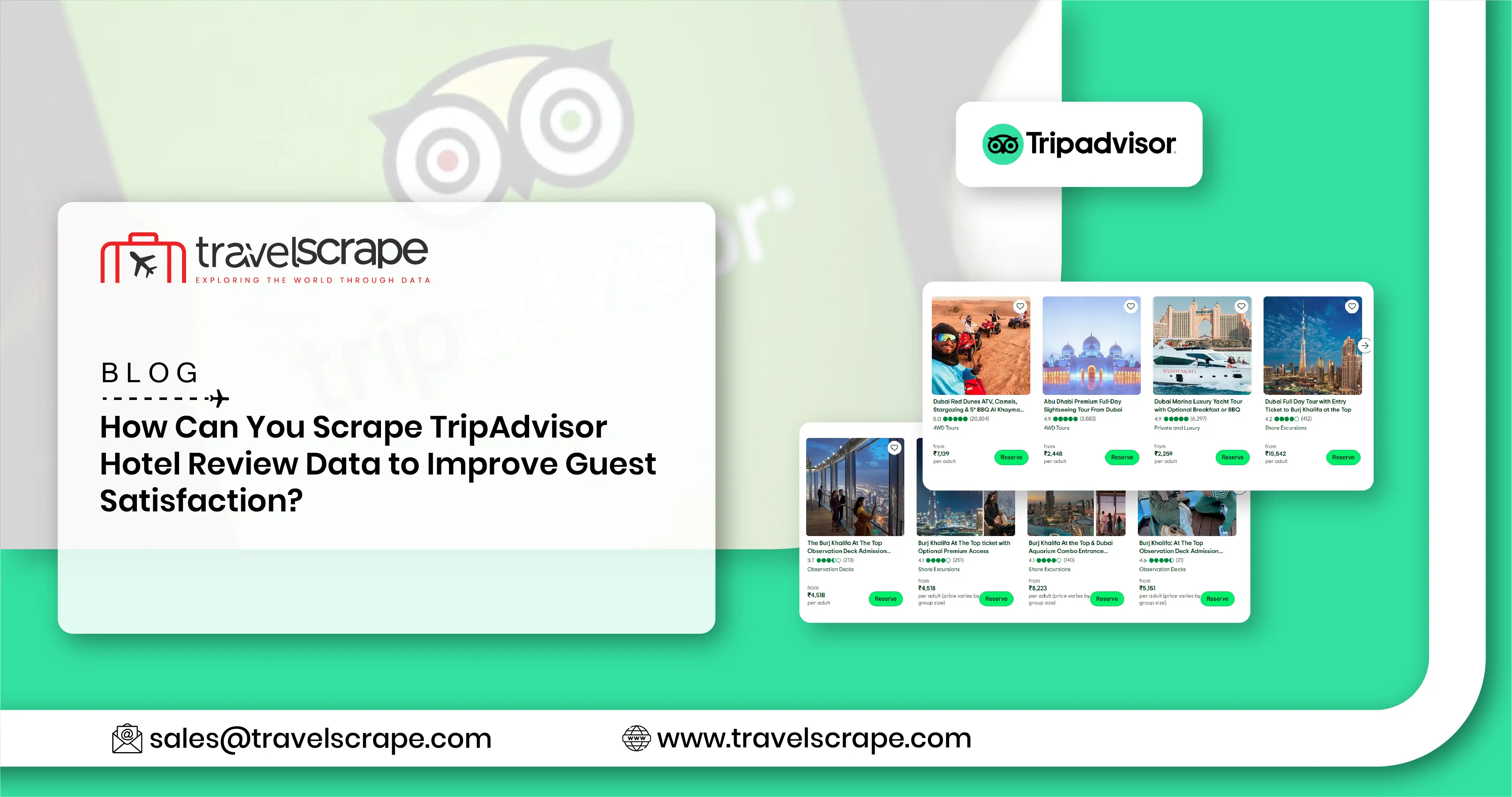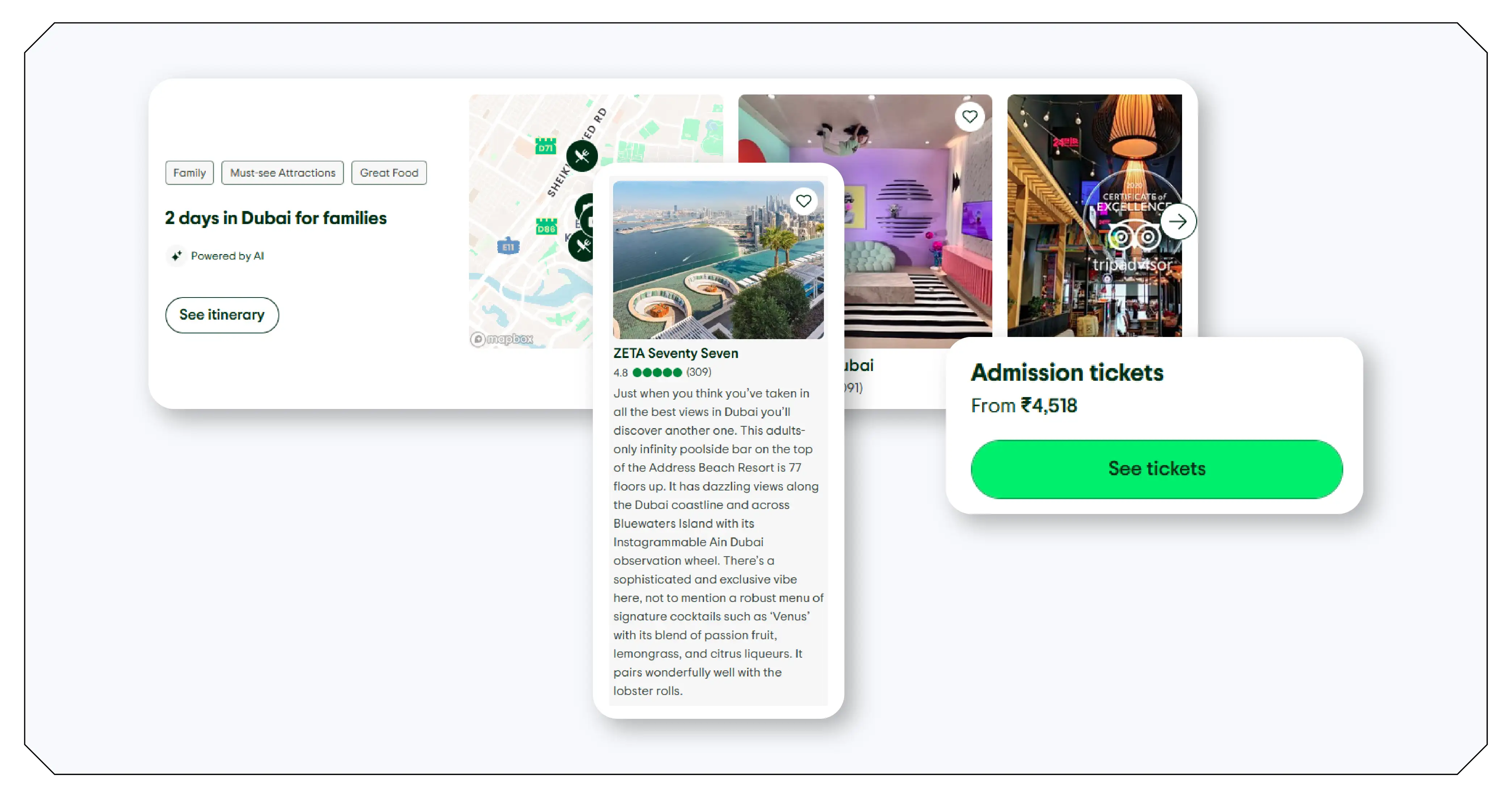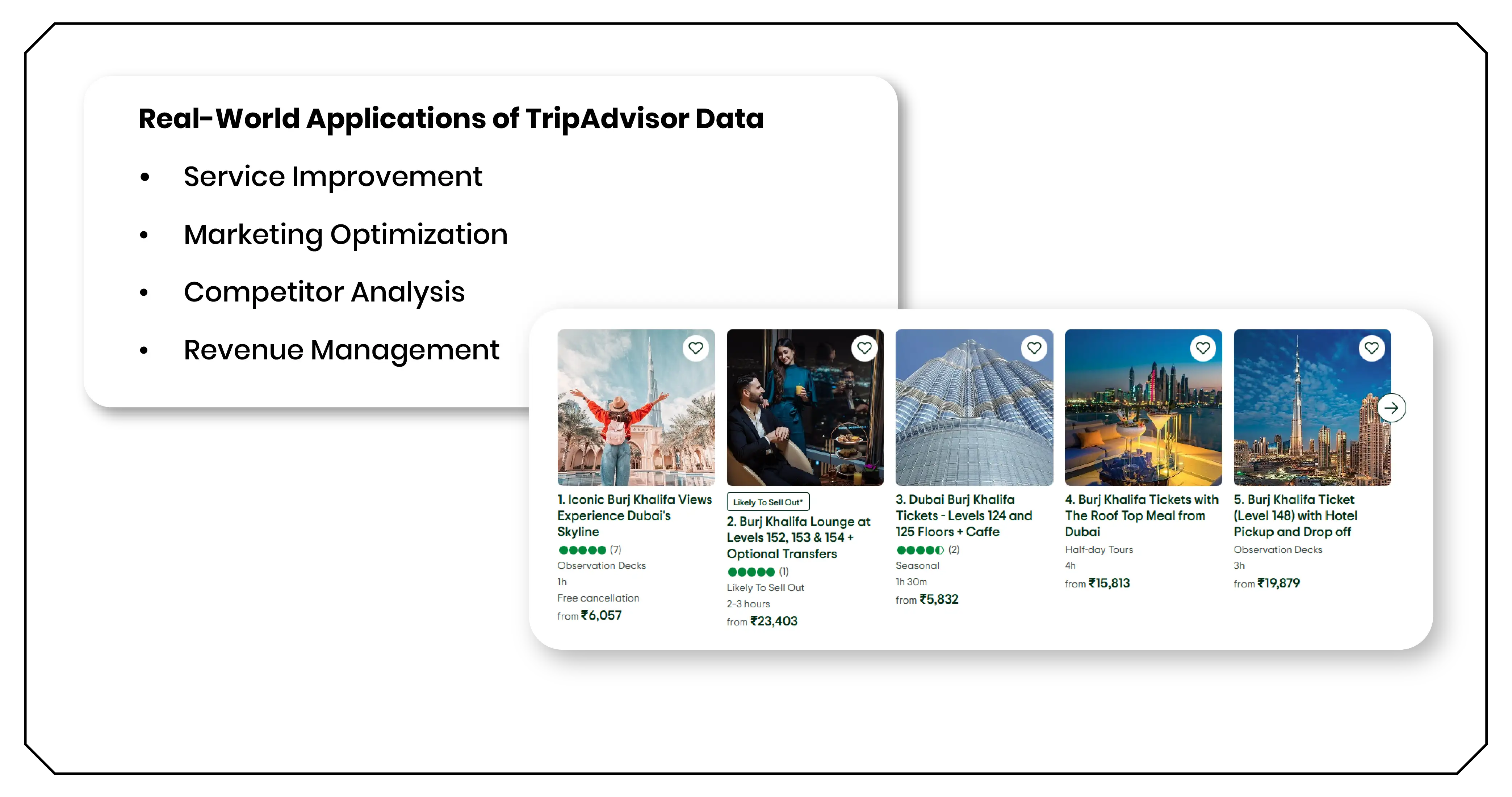How Can You Scrape TripAdvisor Hotel Review Data to Improve Guest Satisfaction?

Introduction
In today’s digital age, customer feedback has become a cornerstone of decision-making for the hospitality industry. Hotels no longer rely solely on internal audits or industry reports to understand guest satisfaction — online reviews have emerged as a powerful source of market intelligence. Platforms like TripAdvisor host millions of reviews from travelers worldwide, providing detailed insights into guest experiences, pricing, and service quality. Businesses that know how to Scrape TripAdvisor Hotel Review Data can transform these insights into actionable strategies to enhance operations, improve guest satisfaction, and boost revenue.
With the rise of Hotel Data Scraping Services, hoteliers, travel analysts, and research firms can now systematically collect and analyze user-generated feedback on TripAdvisor. This approach goes beyond surface-level review reading and enables organizations to capture structured datasets for meaningful analysis. Moreover, the ability to Scrape TripAdvisor Hotel Ratings and Feedback allows businesses to understand not only what guests say but also patterns in ratings, frequency of reviews, and sentiment trends over time.
TripAdvisor has established itself as one of the most trusted platforms for travel reviews. Guests share detailed accounts of their stays, commenting on room cleanliness, staff behavior, amenities, location, food quality, and overall experience. Each review contains structured and unstructured data, including numeric ratings and textual feedback, making it a goldmine for hospitality analytics. Collecting this data in a systematic manner ensures that hotel managers, travel planners, and marketing teams can make data-driven decisions.
Understanding the Value of TripAdvisor Guest Reviews Dataset

A TripAdvisor Guest Reviews Dataset allows hoteliers to quantify and track guest satisfaction trends over time. For example, hotels can monitor changes in average ratings after renovations, staff training programs, or seasonal promotions. By analyzing textual feedback, businesses can uncover recurring issues, highlight unique selling points, and identify service gaps that might not be apparent from numeric ratings alone.
Additionally, the dataset can provide insights into guest demographics, travel purposes, and booking channels. Many reviews indicate whether a guest traveled for business, leisure, family, or special occasions. Aggregating these insights enables hotels to customize their offerings and marketing strategies for different segments. Key insights include:
- Monitoring changes in average guest ratings over time to track satisfaction trends.
- Identifying recurring service issues or operational challenges from textual feedback.
- Highlighting unique selling points that differentiate the hotel from competitors.
- Analyzing guest demographics, including age, nationality, and travel purpose.
- Understanding booking channels and travel types, such as business, leisure, or family trips.
- Customizing marketing strategies and promotional offers based on segmented guest insights.
Benefits of Scraping TripAdvisor for Hotel Rating Trends
Scraping TripAdvisor for hotel rating trends is essential for hotels that want to maintain a competitive edge. By monitoring ratings over time, management can identify patterns that influence guest satisfaction. For instance, if reviews consistently mention slow check-ins or noisy rooms, corrective actions can be prioritized. Conversely, positive trends, such as praise for eco-friendly initiatives or new spa services, can be highlighted in marketing campaigns.
Furthermore, scraping trends provides a benchmark against competitors. Hotels can compare their ratings and feedback with properties in the same location, star category, or brand segment. This comparative analysis ensures that managers are aware of strengths, weaknesses, and opportunities to differentiate their services.
Competitive Advantage Through TripAdvisor Review Data for Benchmarking
The hospitality industry thrives on competition. Using TripAdvisor review data for competitive benchmarking, hotels can gain insights into rival properties’ performance. Benchmarking involves comparing various metrics, such as average ratings, review volume, sentiment analysis, and recurring complaints. By understanding competitors’ strengths and weaknesses, hotels can implement targeted improvements, optimize service delivery, and position themselves more effectively in the market.
This approach also helps identify emerging trends. For example, if boutique hotels in a city are receiving consistently high ratings for personalized experiences, other properties can adapt by enhancing customer engagement, offering curated packages, or training staff for superior guest interaction.
Unlocking Insights with TripAdvisor Hotel Room Rates Dataset
Pricing strategy is a critical element in hotel management. A TripAdvisor Hotel Room Rates Dataset can help hotels monitor competitors’ pricing, seasonal fluctuations, and dynamic rate adjustments. By correlating room rates with review scores and guest sentiment, hotels can determine the optimal pricing strategy that maximizes occupancy while maintaining profitability.
Moreover, rate datasets allow predictive analytics. Hotels can forecast demand during peak seasons, special events, or holidays based on historical data and competitor pricing trends. This capability ensures smarter inventory management, better promotion planning, and higher revenue per available room (RevPAR).
Extracting Ratings and Reviews for Deep Insights
The true power of TripAdvisor data lies in the combination of quantitative and qualitative analysis. By choosing to Extract TripAdvisor ratings and reviews for insights, hotels gain access to multi-dimensional perspectives on guest experiences. Text mining, sentiment analysis, and topic modeling can identify frequently mentioned issues, such as housekeeping quality, food taste, or noise levels.
Additionally, this analysis can uncover hidden opportunities. For example, reviews might reveal that guests value eco-friendly initiatives or local cultural experiences. Hotels can then tailor marketing messages or design packages to appeal to these preferences.
Leveraging TripAdvisor Price Trends Dataset
In addition to ratings and reviews, price data provides strategic insights. A TripAdvisor Price Trends Dataset helps hotels track room rate fluctuations across competitors, enabling dynamic pricing strategies. It also allows for forecasting demand elasticity, determining optimal promotional periods, and aligning pricing with perceived value.
Integrating price trend data with review analysis ensures that hotels not only offer competitive rates but also provide value that resonates with guest expectations. The combination of pricing insights and guest sentiment creates a holistic understanding of market positioning.
Implementing a Robust Data Scraping Strategy
To effectively leverage TripAdvisor data, it is essential to implement a robust data scraping strategy. This involves:
- Identifying target properties and regions
- Extracting structured datasets of reviews, ratings, and pricing
- Cleaning and normalizing data for consistency
- Applying analytics techniques to uncover trends, sentiment, and correlations
Using professional scraping tools and APIs ensures accurate and timely data collection while maintaining compliance with legal and ethical guidelines.
Real-World Applications of TripAdvisor Data

Hotels and travel companies can apply TripAdvisor insights in numerous ways:
- Service Improvement: Identify recurring complaints and implement corrective actions.
- Marketing Optimization: Highlight strengths and unique offerings in promotional campaigns.
- Competitor Analysis: Benchmark against similar properties to enhance market positioning.
- Revenue Management: Adjust pricing based on demand trends and competitor rates.
- Product Development: Introduce new amenities, packages, or services based on guest feedback.
Additionally, travel agencies can use the insights to recommend properties more effectively, while investors can assess property potential based on guest satisfaction and market trends.
Emerging Trends in TripAdvisor Review Analytics
Modern analytics techniques enhance the value of TripAdvisor data. Machine learning and natural language processing allow for advanced sentiment analysis, categorization of complaints, and prediction of future guest satisfaction. These techniques convert raw data into actionable intelligence that supports strategic decision-making.
Hotels are increasingly integrating TripAdvisor data with internal PMS systems, CRM platforms, and marketing tools. This integration enables a 360-degree view of guest preferences, behavior patterns, and operational performance, allowing for personalized services and targeted campaigns.
Challenges and Best Practices
While TripAdvisor data is valuable, there are challenges to consider:
- Data Volume: Millions of reviews require efficient storage and processing solutions.
- Data Quality: Cleaning and standardizing text and ratings is critical.
- Ethical Compliance: Ensure scraping practices respect platform policies and data privacy laws.
Best practices include focusing on relevant metrics, combining quantitative and qualitative analysis, and continuously monitoring trends to adapt strategies.
How Travel Scrape Can Help You?
- Comprehensive Market Insights: Access structured and up-to-date data on hotel reviews, ratings, room availability, and pricing across multiple platforms to make informed business decisions.
- Competitive Benchmarking: Compare your hotel’s performance with competitors, track their strengths and weaknesses, and identify opportunities to differentiate your offerings.
- Enhanced Customer Understanding: Analyze guest feedback and reviews to uncover trends, preferences, and pain points, enabling personalized services and improved guest satisfaction.
- Revenue Optimization: Monitor pricing trends, occupancy patterns, and seasonal demand to implement effective revenue management and dynamic pricing strategies.
- Data-Driven Strategy: Transform raw hotel data into actionable insights for marketing, operations, and strategic planning, ensuring smarter and faster business decisions.
Conclusion
In today’s competitive hospitality industry, the ability to Extract Real-Time TripAdvisor Review Data for Hotels provides a significant edge. By leveraging this data, hotels can proactively anticipate guest expectations, improve service quality, and optimize pricing strategies to maximize revenue. Utilizing TripAdvisor scrape Hotel review analytics, businesses gain actionable insights that inform marketing campaigns, operational improvements, and strategic decision-making. Analyzing reviews and ratings enables hotels to understand customer sentiment, identify trends, and benchmark performance against competitors. This data-driven approach enhances decision-making, strengthens guest satisfaction, and reinforces Hotel Data Intelligence as an essential tool for modern hotel management and growth.
Ready to elevate your travel business with cutting-edge data insights? Scrape Aggregated Flight Fares to identify competitive rates and optimize your revenue strategies efficiently. Discover emerging opportunities with tools to Extract Travel Website Data, leveraging comprehensive data to forecast market shifts and enhance your service offerings. Real-Time Travel App Data Scraping Services helps stay ahead of competitors, gaining instant insights into bookings, promotions, and customer behavior across multiple platforms. Get in touch with Travel Scrape today to explore how our end-to-end data solutions can uncover new revenue streams, enhance your offerings, and strengthen your competitive edge in the travel market.

